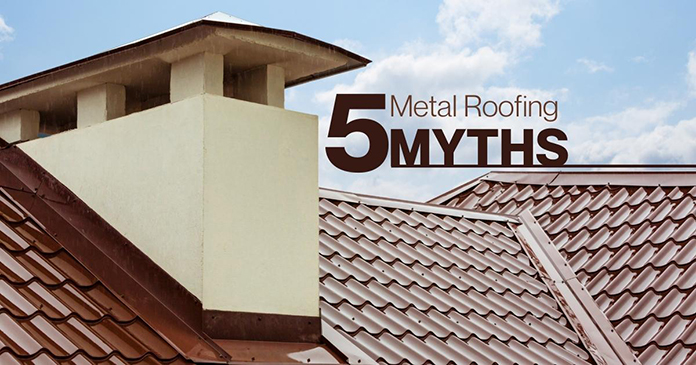Myth vs. Fact: 5 Misconceptions About Metal Roofing
Published: 2/21/2022

Myth vs. Fact: 5 Misconceptions About Metal Roofing
If your roof is looking worse for wear, or nearing the end of its lifespan, you’re probably trying to figure out which type of roofing is the best to replace it. Chances are that you’ve seen metal roofing pop up as a suggestion quite a few times. However, like many, you might be skeptical.
There are a lot of myths floating around that can give the impression metal roofing isn’t a good option. But in fact, this material can offer a value that’s hard to beat. We debunk the top metal roofing myths below and give more information on its outstanding benefits.
REQUEST A
FREE ESTIMATE
Myth #1: Metal Roofs Aren’t Durable
The smooth finish and relatively thin profile of metal roofing is visually deceiving. It causes many to think that metal roofs are more delicate than their shingle-based counterparts, unable to stand up to the stresses of inclement weather. This is a big cause for concern among homeowners in stormy Florida, since we have to consider how well our roofs can stand up to hail, rain, and hurricanes.
Luckily, when it comes to this myth, the opposite is the truth. Metal roofing is incredibly strong, capable of resisting forceful winds and pounding ice. Choosing a corrugated version can further enhance its strength, and hide any imperfections that may result from the impact of especially large hailstones. Contrary to another popular belief, almost all of today’s metal roofing is rust-proof as well, meaning it can easily endure in Florida’s humid conditions.
Myth #2: Metal Roofing Attracts Lightning
Metal conducts electricity. Therefore, it seems like a no-brainer that having a metal roof would put your home at a much greater risk of being struck by lightning – right?
Surprisingly, this is actually wrong. Not only is a metal roof not any more likely to be struck by lightning, it can also provide better protection in the event that it is hit. The conductivity of metal is actually a saving grace in this respect, since it will distribute the electricity evenly across the roof. On traditional rooftops, all that electricity would stay focused on a central point, significantly increasing the chance of causing damage. Furthermore, the fact that metal roofing is non-combustible offers a safeguard against possible fire ignition that commonly results from lightning strikes.
So if you’re particularly worried about lightning hitting during one of Florida’s notorious storms, a metal rooftop may be the best choice you could possibly make.
Myth #3: Metal Roofing Increases Cooling Costs
Another elemental concern many have is that metal’s tendency to heat up can cause your home to become a magnet for the sun’s rays. This is believed to make your home prone to getting too warm during hot Florida days, putting far more demand on your air conditioning system. Shingles start to look like the more energy-efficient option when working under this assumption.
Again, with this myth, the opposite is true. Shingles unexpectedly tend to be greater absorbers of heat, while metal reflects sun beams away from your home. This property, known as “high emissivity”, is actually what makes metal feel hot when it has been exposed to heat; instead of sucking up all that warmth and storing it at its core, metal radiates it upward and outward. Deflecting the heat keeps your attic cooler than it would be with shingles, reducing your overall cooling needs. This is why it’s so common to see metal rooftops on today’s most energy efficient homes.
Myth #4: Metal Roofing is Too Heavy for Standard Roof Structures
Sprawling metal sheets may seem like a big load to bear. A lot of homeowners worry that they’re too weighty to be properly supported by the beam structure of the attic below.
However, metal roofing turns out to be one of the most lightweight options on the market. Whereas shingles can weigh several hundred pounds per square foot, the lightest metal types (such as aluminum) can weigh as little as 50. The saved weight load becomes even more dramatic when compared to shingle installations that are layered over old ones.
On average, metal roofing is half as heavy as standard roofing, with even more disparity between it and high-end shingles or tiles. So any concerns over structural weakness should make metal the preferred choice, rather than the worst.
Myth #5: Metal Roofing Looks Too “Industrial” for Residential Use
Thanks to its strength and cost efficiency, metal roofing is a popular choice for many commercial applications. This has built the association with metal roofing and more spartan, industrial-style builds. As a result, many homeowners assume that installing a metal roof will look out of place on all but the most modern houses.
This may have been the case years ago, but today, there are a wealth of fashionable options friendly for residential settings. It’s possible to get metal roofing in a wide variety of colors and textures, with some sheets even being formed to look like classic tiles and shingles. In the 2020s, there’s just no limit on what kind of aesthetic can be achieved with a metal rooftop.
Find Expert Metal Roofing Contractors in Sarasota
If you’re ready to learn more about what type of roofing may be best for your home, our experts can walk you through the pros and cons of each option. Our crew is skilled at installing metal, tile, shingle, and even single-ply roofing on all building types, including residential housing.
We provide free inspections and estimates, giving you a chance to obtain an informed recommendation and quote without any risk. Contact us today to set up your convenient, contactless appointment.

See What Our Customers Are Saying
Recent Posts
Choosing A Multi-residential Roofer
Choosing The Best Roofer
Energy Efficient Roofing Solutions
How Long Does It Take To Replace A Roof?
Debunking 10 Common Roofing Myths
2025 Roofing Tech & Trends
How To Choose Color For Tile Roof
What Is Drip Edge?
What Do Roof Vents & Penetrations Do?
How Roofs Impact Market Value
Best Roof for Florida
Maximizing Energy Efficiency
Roof Inspections 2024
Prepare Your Roof For Spring
Lifespan of Different Roofing Materials
How Roof Type Affects Value
Choosing Materials for Extreme Weather
Guide to Cleaning Gutters Safely
Emergency Roof Repair: What to do until the professionals arrive
New Roof Tech: GAF Solar Energy Shingles
How to Minimize Fire Hazards on Roof
How Florida Heat Affects Roof
Top Benefits of Shingle Roofs
Solar Options for Florida Homes
What to do if Hurricane Damages Roof
2023 Hurricane Season Roof Preparation Checklist
Does Adding Solar Increase Your Home's Value?
What it takes to be a GAF Master Elite Contractor
How To Choose The Right Roof Shingles
How To Choose The Right Windows & Doors For Your Home
How To Choose Solar Energy System For Your Home
What To Do If Tree Falls On Your Roof
Residential Roof Spring Cleaning Checklist
Should You Replace Your Gutters When You Replace Your Roof?
New Homeowners' Guide To Roof
Roof Warranties
2023 Solar Energy Trends
Time To Replace Front Door
Roofs With Curb Appeal
Roof is Leaking During Storm
New Roof vs. Repair